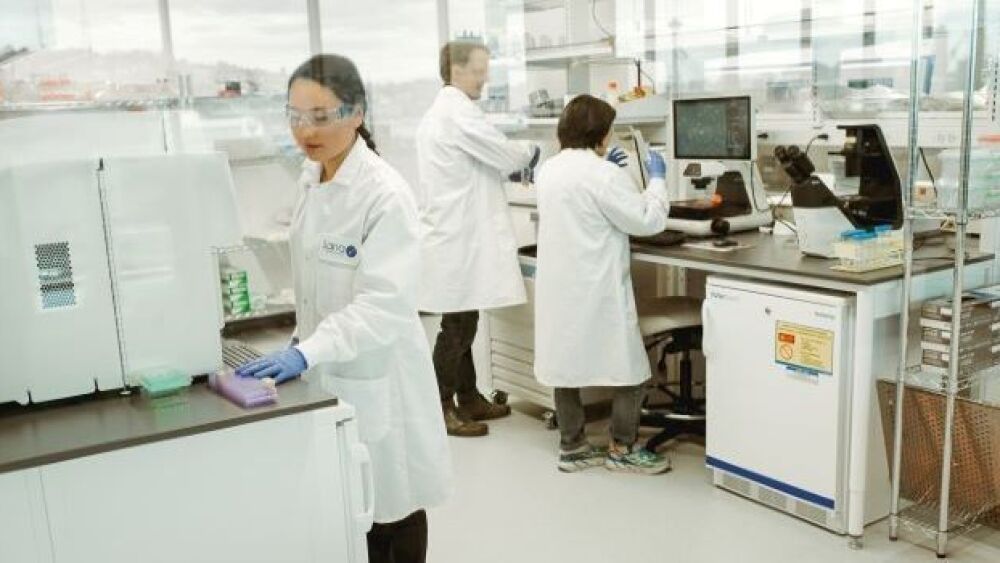Sana Biotechnology, a gene and cell therapy hybrid whose mission is to create and deliver engineered cells as medicines for patients, puts the “I” first in Inclusion, Diversity and Equity (IDE).
Sana employees, pictured in a company laboratory, work to create engineered cells as medicine.
Sana Biotechnology, a gene and cell therapy hybrid whose mission is to create and deliver engineered cells as medicines for patients, puts the “I” first in Inclusion, Diversity and Equity (IDE).
“Inclusion is the soil from which we’ve built our culture, and we know that we need diversity of thought, input, and capabilities in order to make these very complex medicines a reality,” said Sana President and Chief Executive Officer, Steve Harr, MD.
Sana is developing its cell engineering platform to deliver any payload to any cell in a specific, predictable, and repeatable way, using its cell cloaking technology to overcome the immune barriers of allogeneic cells.
Harr’s philosophy is that intentional inclusion must come before any kind of meaningful diversity.
“We need to have a culture that fosters inclusivity and diversity as we grow. Otherwise, people will not feel wholly part of the organization, they will not feel empowered to be their true selves, and we will have a hard time retaining them,” he said.
While almost every organization these days is quick to emphasize the priority it places on IDE or DEI, Harr believes that the effort is integral to the future of Sana and its purpose, stating, “Culture isn’t a goal in and of itself, it is a hugely important means to reach our company’s goal.”
To this end, he has tapped Farah Anwar, Sana’s Head of Development Operations, to lead the company’s IDE program. Having a senior executive in this role provides a unique perspective.
“I think one of the benefits of sitting in the business as an IDE leader is that I’m involved in the day-to-day work, so I’m not an observer looking in. I feel it. I understand how it feels to be in a meeting, what the dynamics are there, and can have sort of an observer and participant view at the same time of what we need to do better,” said Anwar, who has chaired Sana’s diversity committee, ‘Voices at Sana’, since the company’s inception in 2018.
Anwar is also able to leverage her extensive clinical and operational experience, most recently as vice president of clinical operations at Juno Therapeutics, to constantly be improving Sana’s IDE initiatives.
“Having that operational background working with teams, working with clinical sites, working in clinical trials, it’s really all about course correcting as you go, because nothing ever goes as planned. I think it’s not just setting your plans in motion, but constantly evaluating them to see if they are working, not working, what can we do better, what have we not thought about,” she explained.
This capability is key to an effective IDE program, because as Harr said, “you have to have a long-term view. I don’t think this is something that we can solve overnight. It’s something that we are going to have to invest in over the long-term as an organization, as an industry, and as a society to really bridge that gap.”
Sana also knows that a dedication to inclusivity and diversity must begin at the outset of the hiring process.
“We’ve set very clear criteria around the need for diversity within interview slates. Secondly, we have really spent time eliminating biased words in our job descriptions. We have trained our people around their own unconscious biases and how they can creep into the interview process, and on mechanisms to overcome that,” shared Harr.
One of these mechanisms is a novel approach Sana has developed to hedging against and troubleshooting the aforementioned unconscious biases.
“We have three people who are outside a traditional hiring team: a culture bar raiser, a leadership bar raiser, and a technical bar raiser. We are exploring ways to train all the culture bar raisers to really be the ones who are combating bias within that interview process during the debrief, so that there is always someone in that room coming in with that lens,” Anwar said.
The team is not only focused on building an inclusive culture at Sana. As Anwar explained, this is a broader calling.
“I do believe our focus on inclusion will help us deliver for patients and also create the next generation of leaders with this inclusive mindset. We do this at Sana, and we can also make an impact throughout the biotech world, even as such a young, small company, with this type of focus,” she said.
Sana’s commitment to inclusion and diversity naturally extends to its vision of serving patients.
“If we create a medicine and a patient doesn’t have access to it, it’s a science experiment, not a therapy,” Harr said. “From the start, we ask the question: is what we are doing scalable? That doesn’t mean that it’s scalable today, we understand that. But do we believe it will be scalable so we can broadly deliver this therapy to patients around the world? If we don’t, we say ‘let’s keep working’.”
A concerted focus on diversity and inclusion is vital to this mindset.
“I think first and foremost, a biotech company has a bit of a pact with society: that we will deliver better healthcare outcomes for people broadly. You cannot deliver on that promise, or the responsibility the industry has, without understanding the diversity of biology, understanding the diversity of social environments that exist in the world, and getting input from people with hugely different experiences,” Harr said.
While holding a tremendous amount of promise, gene and cell therapy are also notoriously expensive, and Sana is working hard to bridge this gap as well.
“We really do have an organization that’s maniacally focused around cost of goods, because when you control your cost of goods, you have more levers to pull in ensuring accessibility. I want to hold us accountable as an organization for being part of the solution and really beginning to bend the cost curve,” Harr said.
And he is confident that his team of approximately 300 strong will never let leadership forget this core purpose.
“I ask every person one question when they join, which is ‘why Sana?’ Among the top three reasons is this idea around really being committed to patient access. So, I know that the organization will hold us accountable for delivering upon it, because it’s a core part of why a lot of people are here,” Harr stated.
While he would like for every new hire to memorize all of Sana’s values, Harr asks that they remember at least this one:
“We make each other better than we ever thought possible.”
Featured Jobs on BioSpace






